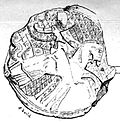| Monarchy of Albania | |
|---|---|
| Monarkia e Shqipërisë | |
 | |
 Last Monarch Victor Emmanuel III | |
| Details | |
| Style | His Majesty |
| First monarch | Progon, Lord of Kruja |
| Last monarch | Victor Emmanuel III |
| Formation | Approximately 1190 AD. |
| Abolition | 8 September 1943 |
| Residences | Royal Palace of Tirana Royal Palace of Durrës Royal Villa of Durrës Burgajet Castle |
| Pretenders | Leka, Crown Prince of Albania Leka, Prince of Albania |
This is an archontological list of Albanian monarchs, containing monarchs of the medieval Albanian principalities, Albanian kingdoms and to heads of state of modern Albania . Starting from the first established monarch Progon of Kruja from the Progoni family who ruled the Principality of Arbanon starting in 1190. Throughout history, the monarchs of Albania have held multiple different titles, often Latin or Byzantine, and in rare instances, Slavic. Some of these titles include King of Albania, Prince of Albania, Despot, and Sebastokrator. Members of the medieval Albanian monarchy were integral to the formation of the Albanian nobility. The monarchy in Albania was abolished on the 8th of September, 1943.
Contents
- Principality of Arbanon (1190–1257)
- House of Progoni
- House of Kamona
- Unknown
- Principality of Gropa (1258–????)
- House of Gropa
- Principality of Blinishti (13th century–1330)
- House of Blinishti
- Kingdom of Albania (1272–1368 & 1376-1383)
- House of Anjou
- Principality of Muzaka (1279–1450)
- House of Muzaka
- Principality of Mataranga (1358–1367)
- House of Mataranga
- Principality of Gjonima (1319–1430)
- House of Gjonima
- Principality of Albania (1328–1415)
- House of Thopia
- Principality of Vlorë (1345–1417)
- House of Sratsimir
- House of Balsha, House of Muzaka & House of Žarković
- Principality of Zeta (1356–1421)
- House of Balsha
- Despotate of Angelokastron and Lepanto (1358–1374)
- Shpata dynasty
- Despotate of Arta (1360–1416)
- Losha dynasty
- House of Shpata
- Principality of Gjirokastër (1386—1418)
- House of Zenebishi
- Principality of Dukagjini (1387–1479)
- House of Dukagjini
- Principality of Arianiti (????–1462)
- House of Arianiti
- Principality of Kastrioti (1389–1444)
- House of Kastrioti
- Principality of Zaharia (1396–1447)
- House of Zaharia
- Principality of Spani (1400-1442)
- House of Spani
- Principality of Dushmani (1402-1444)
- House of Dushmani
- League of Lezhë (1444–1479)
- House of Kastrioti 2
- House of Dukagjini 2
- Pashalik of Shkodra (1757–1831)
- House of Bushati
- Pashalik of Berat (1774–1809)
- House of Berat
- Pashalik of Ioannina (1788–1822)
- House of Meçohysaj
- Principality of Albania (1914-1925)
- House of Wied
- Heads of House of Wied (1914–1973, not ruling)
- Albanian Kingdom (1928–1939)
- House of Zogu
- House of Zogu (1939–1945)
- Italian Occupied Albanian Kingdom (1939–1943)
- House of Savoy
- See also
- Bibliography
- References
- External links































